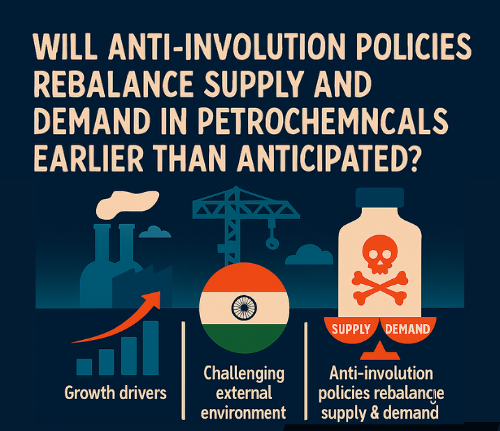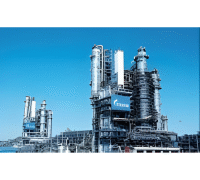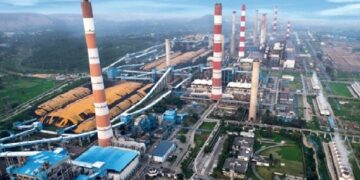India’s appetite for petrochemicals is projected to sustain strong growth in the near term, supported by an economic outlook that ranks it among the fastest-growing economies globally. Demographics play a pivotal role, with a youthful population eager and capable of spending, driving consumption of goods and services. Rapid urbanization will further escalate the need for materials and chemicals.
The potential for expansion is highlighted by the fact that per capita consumption remains well below global benchmarks. At $220 billion, the Indian chemical market constitutes only 3.7% of the global total, whereas China, by comparison, holds a 46% share.
In response to these demand signals, numerous petrochemical projects are either underway or in planning stages, primarily led by oil refiners aiming to diversify beyond fuels. While these investments are essential, they remain insufficient, and imports will continue to meet a substantial portion of market requirements.
However, the bright investment outlook is clouded by a challenging external environment. Globally, petrochemical capacity far exceeds demand, and conventional wisdom suggested that supply-demand equilibrium would only be restored by the decade’s end—or, in a pessimistic scenario, mid-next decade. But could this adjustment occur sooner?
Growth Drivers
According to Argus Media estimates, India’s overall chemical demand is currently growing at approximately 6.5% CAGR, compared to 3.6% globally.
Plastics represent a significant segment, with growth fueled not just organically but also through substitution from other materials. While such shifts have already occurred extensively in packaging (away from glass, metals, jute, etc.), the automotive sector still presents opportunities to capture share from other materials, particularly metals. Plastics in automobiles provide benefits like lightweighting, design flexibility for distinctive branding, and improved fuel efficiency. The rise of electric vehicles further accelerates demand, as these generally incorporate more plastics than conventional internal combustion engine vehicles.
Government-led social sector initiatives in housing, urban development, agricultural productivity enhancement, and water distribution, alongside broad urban infrastructure projects, are also adding momentum to demand.
Historically, improved domestic availability of petrochemicals has the potential to boost growth even further.
Upcoming Projects
Petrochemical projects totaling around $36 billion in capital expenditure are either ongoing or in advanced planning stages, expected to come online by decade-end. Many are led by refineries in both the public and private sectors, with a focus on polymers, though certain chemical projects, such as propylene-based plants, are also in the pipeline. With the government prioritising self-reliance to mitigate uncertainties, investments are expected to rise to $87 billion in the early 2030s.
Unlike the past, where Gujarat and Maharashtra dominated activity, new projects are emerging across Kerala, Tamil Nadu, Karnataka, Andhra Pradesh, Odisha, and West Bengal—mostly coastal regions with existing or planned maritime logistics. Some planned facilities in Chemical Parks, located at safe distances from major population centers, aim to enhance operational efficiency and safety.
Most projects target import substitution, a market with substantial potential. In 2024, India imported 2.5 million tons of polyethylene (40% import dependency), 1.5 million tons of polypropylene (15%), 3.2 million tons of polyvinyl chloride (60%), 2.6 million tons of methanol (over 90%), and nearly 2 million tons of purified terephthalic acid (PTA). Other significant imports included monoethylene glycol (975 kt), para-xylene (918 kt), and toluene (575 kt).
Difficult External Environment
While domestic challenges like high capital costs, inadequate infrastructure, and lengthy approvals persist, the more pressing concern is the external environment. Imports from cost-competitive regions such as the Middle East have long influenced the industry, compounded by large-scale low-price dumping, particularly from China. Tariff and non-tariff measures are further reshaping trade flows and creating uncertainties.
Ethylene, the largest olefin, exemplifies the situation. Between 2018 and 2025, global capacity additions averaged 10 million tons annually, while demand grew only about 6 million tons, compressing operating rates, squeezing margins, and prompting capacity rationalisations, especially in high-cost regions like South Korea and Western Europe. A silver lining is that ethane-cracking margins remain attractive, explaining global interest in this feedstock, predominantly exported by the US from the Permian Basin. Reliance Industries has imported roughly 2 million tons of ethane over recent years, while GAIL and ONGC are establishing logistics and contracts to tap into this supply. Multi-feed cracker strategies help mitigate risks from single-country dependence while improving margins. The US Energy Information Agency projects that high ethane production and export capacity could continue for at least 20 years.
In the propylene value chain, propane dehydrogenation (PDH) units converting propane to polypropylene have faced negative margins due to high propane costs and low propylene prices, following four strong years (2017–2021). Overcapacity is a factor—while average annual demand growth from 2014–2024 was about 4.2 million tons, capacity additions averaged 8.7 million tons. Much of the new PDH capacity emerged in China, where the PDH share is expected to increase from 18% in 2018 to 37% in 2033. China is projected to account for 46% of global propylene capacity and 72% of PDH capacity. Refiners also invested in high-severity fluid catalytic crackers to boost propylene yields.
India is entering the PDH space, with GAIL (Usar, Maharashtra) and Petronet LNG (Dahej, Gujarat) planning 500 ktpa and 750 ktpa units, respectively.
In aromatics, polyester demand is driving growth. India’s PX deficit will expand as new PTA capacity totaling 5.4 mtpa comes online over the next three years. Benzene surpluses will continue, creating opportunities for value addition in derivatives like styrene, phenol/acetone, and linear alkyl benzene. Toluene production, currently below domestic requirements, is expected to rise with two new recovery plants but will remain short.
Rebalancing Supply and Demand via Anti-Involution Policies
Globally, petrochemical margin recovery depends on demand-supply realignment, requiring both demand growth and capacity rationalization. With China representing nearly half of global chemical demand, worldwide recovery hinges significantly on developments there.
Recent analyses suggest supply rationalization could occur sooner than previously projected. Morgan Stanley notes that anti-involution measures in China have prompted several chemical producers to shutter operations amid rising production costs. Projects slated beyond 2026 face uncertainty pending the country’s Five-Year Plan, anticipated to introduce further anti-involution policies. Stricter approvals for new capacity and phase-out of small, uncompetitive plants could gradually rebalance China’s chemical industry and, by extension, the global market, supporting more stable pricing.
China’s policies on shutting down and upgrading aging petrochemical and refinery facilities are not new. What has shifted is the urgency to implement change—something a centrally controlled economy can achieve relatively quickly.
Elsewhere, plant closures in the EU, Japan, and South Korea are also tightening supply. Morgan Stanley estimates over 10% of capacity for aramid fibers, toluene diisocyanate, and methyl methacrylate will be withdrawn between 2022 and 2027.
These developments remain limited and initial. Correcting years of overcapacity will require far more restructuring in China and other regions.







